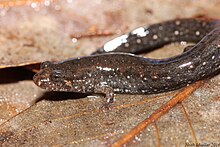| Holbrook's southern dusky salamander | |
|---|---|

| |
|
Scientific classification
| |
| Domain: | Eukaryota |
| Kingdom: | Animalia |
| Phylum: | Chordata |
| Class: | Amphibia |
| Order: | Urodela |
| Family: | Plethodontidae |
| Subfamily: | Plethodontinae |
| Genus: | Desmognathus |
| Species: | D. auriculatus
|
| Binomial name | |
| Desmognathus auriculatus (
Holbrook, 1838)
| |
| Synonyms | |
Holbrook's southern dusky salamander (Desmognathus auriculatus), previously known as just the southern dusky salamander, is a species of salamander endemic to the southeastern United States. Older sources often refer to it as the eared triton. [2] Formerly abundant, it has precipitously declined since the 1960s. [3]
Taxonomy
As previously defined as the southern dusky salamander, it was thought to range from southern Virginia south to Florida, and west to Texas. However, a 2008 study found D. auriculatus as previously defined to be polyphyletic, with many populations being assigned to this species on the basis of similar morphology; for example, Texas populations were found to belong to the spotted dusky salamander (D. conanti). Several other populations assigned to this species were found to be northern dusky salamander (D. fuscus), D. conanti, or undescribed species. [2] [4] In 2017, one of these species was described as Valentine's southern dusky salamander (D. valentinei). [5] A 2020 study identified three distinct mito-nuclear lineages that likely represented distinct species: D. auriculatus A (D. auriculatus sensu stricto), D. auriculatus B, and D. auriculatus C. [6] [7]
It was described by John Edwards Holbrook and renamed after him in 2017 to distinguish it from D. valentinei. [5]
Desmognathus fuscus carri was a subspecies of the northern dusky salamander thought to have existed in peninsular Florida prior to its unexplained disappearance in the 1970s. A 2021 phylogenetic analysis found it to belong to D. auriculatus sensu stricto, albeit being a distinct genetic lineage of it. [7]
Distribution
The three lineages presently assigned to D. auriculatus range along the Atlantic coastal plain from southern Virginia south to peninsular Florida, and west to the Florida Panhandle and southern Alabama. However, populations from Virginia south to Georgia are now thought to belong to the distantly related lineages D. auriculatus B and D. auriculatus C, representing undescribed species. [6] [7] D. auriculatus A, the "true" D. auriculatus, ranges from southern Georgia south to peninsular Florida, and west to the Florida Panhandle and southern Alabama. [2] [5]
Description


Holbrook's southern dusky salamander grows from 3 to 6 inches in length. It is typically dark brown to black in color, with a long tail, and rear legs which are noticeably larger than its front legs. [5]
Behavior
Holbrook's southern dusky salamander prefers tannic, swampy areas near ponds or on the flood plain of streams and rivers. It is largely nocturnal. Breeding takes place in the fall months, and females lay eggs in moist, sheltered areas of ground debris. [5]
Threats
The "true" D. auriculatus, D. auriculatus A, was formerly abundant but has experienced major, unexplained declines since the late 1960s to 1970s, disappearing from large areas of optimal, undisturbed habitat. They are now found in less than 1 percent of their former range. Although it persists at several sites in southern Georgia and northern Florida, it has seemed to have disappeared entirely from peninsular Florida. The exact causes of these declines remain unknown, as other salamanders inhabiting the areas, including other Desmognathus species, have not seen the same declines experienced by D. auriculatus. [7] [3]
References
- ^ IUCN SSC Amphibian Specialist Group (2022). "Desmognathus auriculatus". IUCN Red List of Threatened Species. 2022: e.T200107426A58034937. doi: 10.2305/IUCN.UK.2022-2.RLTS.T200107426A58034937.en. Retrieved 24 December 2022.
- ^ a b c "Desmognathus auriculatus (Holbrook, 1838) | Amphibian Species of the World". amphibiansoftheworld.amnh.org. Retrieved 2021-12-22.
- ^ a b "Disappearing salamanders: New research aims to solve a decades-old mystery". Mongabay Environmental News. 2018-12-27. Retrieved 2021-12-22.
- ^ Beamer, David A.; Lamb, Trip (2008-04-01). "Dusky salamanders (Desmognathus, Plethodontidae) from the Coastal Plain: Multiple independent lineages and their bearing on the molecular phylogeny of the genus". Molecular Phylogenetics and Evolution. 47 (1): 143–153. doi: 10.1016/j.ympev.2008.01.015. ISSN 1055-7903. PMID 18337126.
- ^ a b c d e Means, D. Bruce; Lamb, Jennifer Y.; Bernardo, Joseph (2017-05-10). "A new species of dusky salamander (Amphibia: Plethodontidae: Desmognathus) from the Eastern Gulf Coastal Plain of the United States and a redescription of D. auriculatus". Zootaxa. 4263 (3): 467–506–467–506. doi: 10.11646/zootaxa.4263.3.3. ISSN 1175-5334. PMID 28609856. S2CID 33461333.
- ^ a b Beamer, David A.; Lamb, Trip (2008-04-01). "Dusky salamanders (Desmognathus, Plethodontidae) from the Coastal Plain: Multiple independent lineages and their bearing on the molecular phylogeny of the genus". Molecular Phylogenetics and Evolution. 47 (1): 143–153. doi: 10.1016/j.ympev.2008.01.015. ISSN 1055-7903. PMID 18337126.
- ^
a
b
c
d Pyron, Alex; Beamer, David A.; Holzheuser, Chace R.; Lemmon, Emily Moriarty; Lemmon, Alan R.; Wynn, Addison H.; O’Connell, Kyle A. (2021-12-22).
"Understanding "Alexandrian" extinctions using genomic DNA from fluid-preserved museum specimens of Desmognathus salamanders".
doi:
10.21203/rs.3.rs-769753/v1.
S2CID
238649219.
{{ cite journal}}: Cite journal requires|journal=( help)
- Salamanders of Georgia and South Carolina: Southern Dusky Salamander
- Herps of Texas: Desmognathus auriculatus
